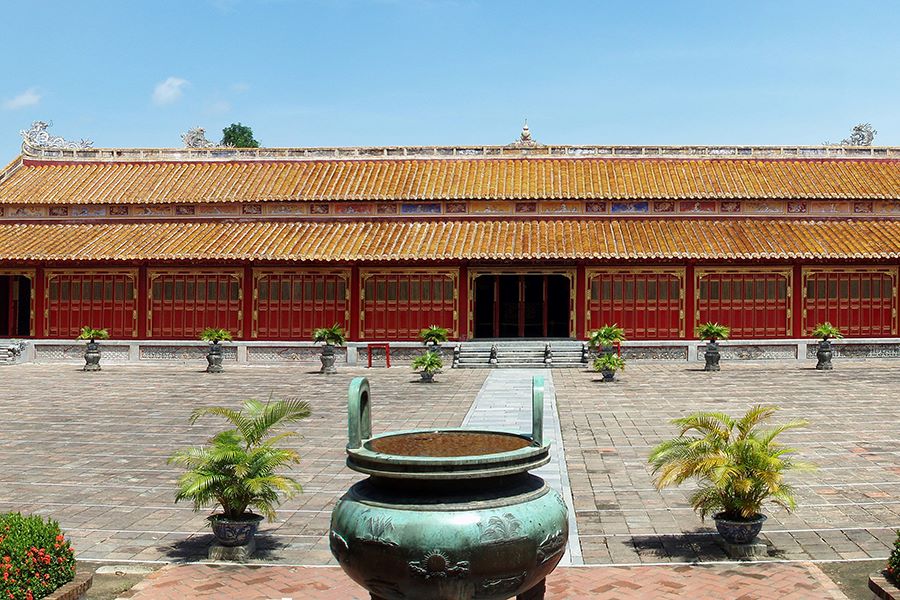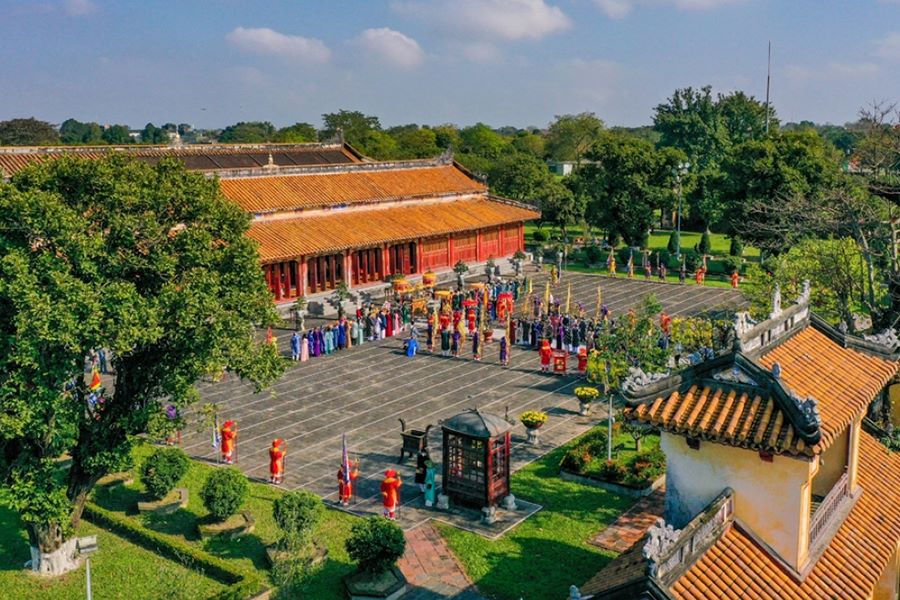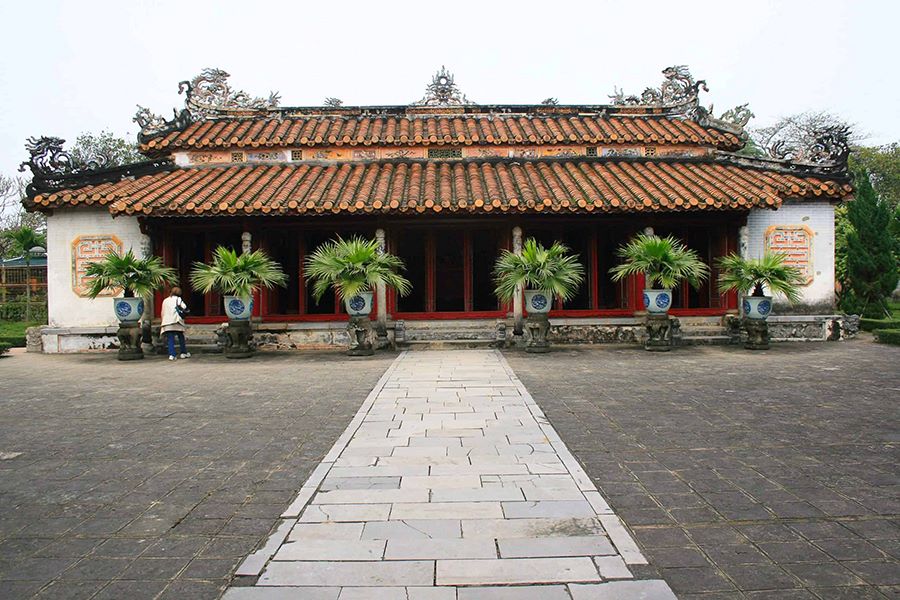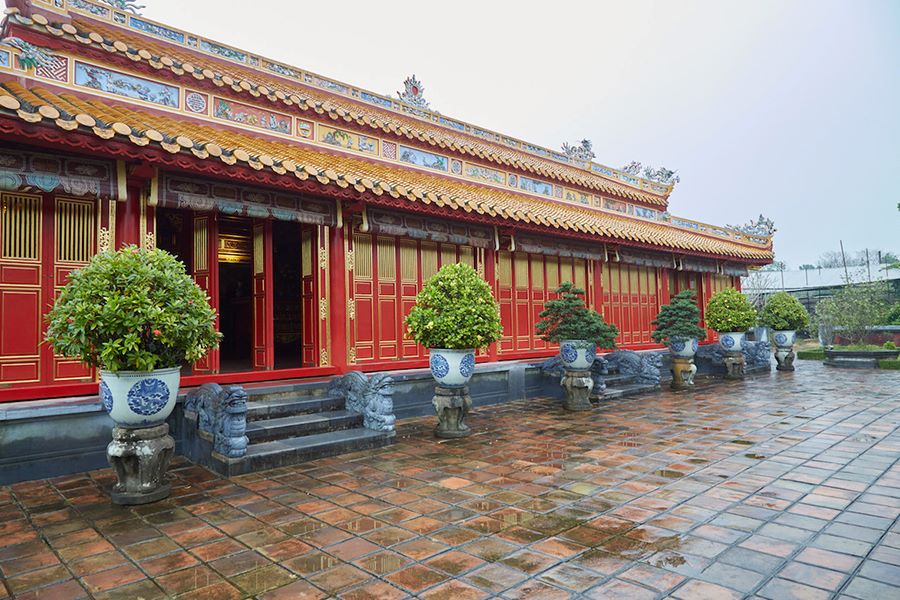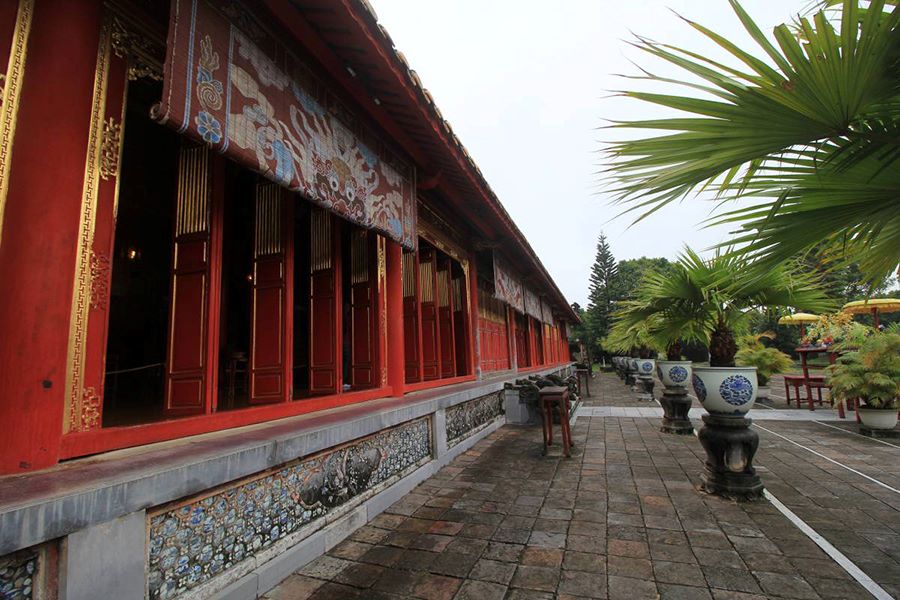To Mieu Temple Complex is a construction for worshiping kings and queens as well as the previous generations of the Nguyen Dynasty. Located in the Hue Imperial City, To Mieu is one of the worth-visiting sites that all tourists cannot miss. Visiting this construction is a chance for tourists not only to discover the typical architecture of Vietnam but also to know more about the history of the Nguyen Dynasty. If you have a chance to visit the To Mieu Temple Complex with Vietnam B2B DMC in India, don’t forget to visit this destination.
History of To Mieu Temple Complex
To Mieu Temple Complex comprises four temples in total, which are Trieu To Mieu (or Trieu Mieu), Thai To Mieu (or Thai Mieu), Hung To Mieu (or Hung Mieu), and The To Mieu (The Mieu).
Trieu To Mieu was built in 1804, the third year under the reign of Gia Long King. Trieu To Mieu was built to worship Nguyen Kim Lord, father of Nguyen Hoang Lord, the two very first ancestors of the Nguyen Phuc family in Central Vietnam. After his death, Nguyen Kim Lord was conferred the posthumous name of Trieu To, so the temple worshiping him was named Trieu To Mieu.
Hung To Mieu is the house of worshiping Nguyen Phuc Luan, father of Gia Long King, the first king of the Nguyen Dynasty. After King Gia Long was enthroned, he built the construction and named Hoang Khao Temple (the temple to worship Father). Hung To Mieu was constructed in April 1804 and completed in August 1804. In the second-year reign of King Minh Mang (1821), the temple was moved about 50 meters to the north, setting space for the construction of The To Mieu. In 1947, the construction was destroyed by fire in an attack by the Viet Minh army in the war. It was not until 1951 that the construction was rebuilt in a new area. In 1995, Hung To Mieu witnessed a large reformation with the appearance we can see nowadays.
Thai To Mieu was another construction in the To Mieu Temple Complex. The construction was also built by King Gia Long in 1804 to worship nine previous lords of the Nguyen Phuc family from Nguyen Hoang Lord to Nguyen Phuc Thuan Lord. Similar to Hung Mieu, Thai Mieu was destroyed by war in 1947. From 1971 to 1972, the Nguyen Phuc family in Hue raised money to rebuild the construction of the old formation of Thai Mieu.
The To Mieu is the most important construction of the To Mieu Temple Complex in Hue Imperial. The To Mieu was built in two years, from 1821 to 1822 under the reign of King Minh Mang. The initial purpose of the temple was to commemorate King Gia Long, the first king of the Nguyen Dynasty, so it was named The To Mieu or To Mieu. Afterward, The Mieu is the place of worship of 7 Nguyen kings. Nowadays, 10 kings are commemorated in The To Mieu.
The Nguyen Dynasty lasted 143 years, under the reign of 13 kings. However, there were only 7 kings worshiped in Thai To Mieu. 6 kings not worshiped in Thai Mieu included King Duc Duc, Hiep Hoa, Ham Nghi, Thanh Thai, Duy Tan, and Bao Dai. According to the Nguyen Phuc family in Hue, King Duc Duc and Hiep Hoa were considered discrowned kings, while King Ham Nghi, Duy Tan, Thanh Thai, and Bao Dai were kings living abroad, so they were all excluded in To Mieu Complex.
In 1954, with the decision of the Nguyen Phuc family, the ancestral tablets of King Ham Nghi, Thanh Thai, and Duy Tan were moved to The To Mieu to worship. However, because there were only nine compartments in The Mieu, the wall on the left of the construction was broken down to build an extra compartment to put the ancestral tablet of King Thanh Thai.
Highlights of To Mieu Temple Complex
Location
To Mieu Temple Complex is located in the interior of Hue Imperial City, which is not similar to the Beijing Palace in China where the place of worship is outside the construction. While in Beijing Palace, there is no place of worship kings and the temples of Heaven, Sun, and Moon are not included in the construction, Hue Imperial City in Vietnam consists of five houses of worship, of which there are four constructions of To Mieu Temple Complex and the other is Phung Tien Palace.
Of the four temples of the To Mieu Temple Complex, Trieu To Mieu and Thai To Mieu are on the left of Thai Hoa Palace, while Hung To Mieu and The To Mieu are on the opposite side. The four constructions lay along the main axis of Hue Imperial, which contains the yin-yang significance as well as the architectural style of the Eastern.
Structure and Architecture
Hung To Mieu
Hung To Mieu was built on a square base with an area of nearly 360 square kilometers. Like other constructions in Hue Imperial, Hung To Mieu is a double-house construction with specific traits of Vietnamese architecture. The two halls of Hung Mieu are linked with each other, each one has a distinct roof, making the construction look like a two-floor house.
Hung Mieu was built on the former base of An Khanh Vuong Tu Temple. The base is 0.68 meters above the surrounding ground. The roof of Hung Mieu was made of double tiles in orange color. Due to the flow of time, the roof and the wall of Hung Mieu are now covered by moss, adorning the antique appearance of the construction. Most of the pillars and beams of Hung Mieu were made of rare and precious wood and decorated in meticulous patterns.
The main hall of Hung Mieu is a house with three compartments and two lean-tos, while the front hall has five compartments and two lean-tos. The ancestral tablets of Nguyen Hung To and his wife were placed in the center of the main hall. The walls of the lean-tos were stylized “Tho” in Chinese character (Tho means “long-lived”).
The front yard of Hung Mieu is in rectangle shape, which is 369 square meters. The front yard was paved in Bat Trang Ceramic, and in the middle is a 2.15-meter-wide main axis. There are flowerpots in front of the main hall of Hung Mieu, and on the right of the yard is an urn for burning papers of petition.
On the left of the ground of Hung To Mieu are two houses called Than Kho (the storage house of the genii) and Than Tru (the kitchen of the genii). Also in the ground, there are two stone steles, one was made in 1804 by Gia Long King, and the other was made in 1821 by Minh Mang King. The two steles marked the time as well as the construction process of Hung Mieu and The Mieu.
Trieu To Mieu
The structure and architecture of Trieu To Mieu are quite similar to Hung To Mieu. Trieu To Mieu is a square-base-temple next to a rectangle yard. Also, a double-styled house covered under a double-tile roof, Trieu To Mieu consists of a front hall and a main hall. The front hall of Trieu Mieu has five compartments and two lean-tos, and the main hall has three compartments and two lean-tos. In the main hall are the memorable tablets of Nguyen Kim Lord and his wife.
In the west part of the yard in front of Trieu Mieu is the house of Than Tru, and on the opposite side is the house of Than Kho. The front yard of Trieu Mieu was also paved in Bat Trang Ceramic, the surrounding are ornamental green plants. The southern wall of Trieu Mieu is linked with Thai To Mieu.
The To Mieu
The To Mieu, or The Mieu, is one of the most significant architectures of Hue Imperial. The Mieu was built in an area of two hectares, which accounts for one-eighteenth area of the Forbidden City. Also on the grounds of The Mieu, tourists can see many other constructions and artifacts such as Hien Lam Cac, Nine Urns, Tho Cong Tu, Canh Y Palace, Ta Vu, and Huu Vu.
The rectangle formation of The To Mieu is nearly 1,500 square meters and 1 meter above the surrounding ground. The To Mieu is also a double-hall house like Hung To Mieu and Trieu To Mieu, but it is four times larger than the two temples. The front hall of The To Mieu comprises eleven compartments and two lean-tos, which is linked with a main hall with nine compartments and two lean-tos. It can be said that The To Mieu is the most imposing construction in the To Mieu Temple Complex, which contains the soul and spirit of the Nguyen Dynasty.
The pillars, beams, and decoration reliefs of The To Mieu were made of wood. The precious kinds of wood used in Thai Mieu are worm eater-resistant, so wooden items can last for such a long time. It is easy to realize the impressive and detailed patterns were carved in pillars, beams, and reliefs. The main theme of these decorations is dragons, sun, clouds, lotus flowers, and leaves, the common patterns in the architecture of temples in Vietnam. The gold lacquer vignettes contribute to the solemn and serene appearance of the interior of The To Mieu.
The center of the main hall of The To Mieu is the altars of Gia Long King and his two wives. On the left of Gia Long King’s altar in succession are the ancestral tablets of King Minh Mang, Tu Duc, Dong Khanh, Ham Nghi, and Thanh Thai. On the opposite side, in succession are the altars of King Thieu Tri, Kien Phuc, Khai Dinh and Duy Tan. Each altar is placed in a distinct compartment. Since there are ten kings worshiped in The Mieu but there are only nine compartments, an extra compartment was added to the left of the main hall to place the altar of Thanh Thai King.
The large front yard of The To Mieu paved in Bat Trang Ceramic has 14 terra-cotta support for flower pots. On the two sides are two copper kylins, which are the symbol of power. Nine Urns (Cuu Dinh) are placed at the end of the yard. The urns symbolize the unity as well as the long-lasting existence of the Nguyen Dynasty. Hien Lam Gac with two gates is the entrance to The To Mieu area. Outside the ground are Ta Vu and Huu Vu, the places to worship the meritorious officials of the Nguyen Dynasty.
Thai To Mieu
Thai To Mieu, the worshiping place of nine lords of the Nguyen Phuc family, from Nguyen Hoang Lord to Nguyen Phuc Thuan Lord. The structure and architecture of Thai Mieu are quite similar to the ones of The To Mieu. However, while The To Mieu remains almost intact as we can see nowadays, Thai To Mieu was destroyed by fire in 1947, and the recent construction was rebuilt based on the former temple.
The To Mieu is also in double-house style as the other three temples. The front hall consists of fifteen compartments, and the main hall has thirteen compartments. Both the two halls included two lean-tos. The altars of nine lords in the Nguyen family were placed in nine compartments inside the main hall.
Thai Mieu also includes a large yard with equivalent constructions to The To Mieu. Tuy Thanh Gac is the main entrance to Thai Mieu, whose architecture and purpose are similar to Hien Lam Gac of The Mieu. Long Duc Palace is in the east and Chieu Kinh Palace is in the west of Thai Mieu. In the south of Tuy Thanh Gac are Ta Vu and Huu Vu putting the altars of some meritorious officials in the 17th and 18th centuries.
Extra Tips for Visiting Mieu Temple Complex
Visiting a spiritual construction, you need to know some tips to have the most convenient journey:
- You should dress politely when entering the temples of To Mieu Temple Complex. Short skirts and sleeveless shirts are not advised.
- The Imperial City of Hue is extremely large, and if you do not want to get lost, prepare yourself a map of this construction. The map is also available in the souvenir shops outside the Imperial.
- If you are not sure where to start and what to see in Hue Imperial in general and To Mieu Complex in particular, going with a tour guide is an ideal selection. A tour guide will not only take you to worthwhile visiting sites but also tell you more about the history and architecture of this construction.
- Photos are not allowed inside the temples of To Mieu Complex. You must notice this tip in order not to get into trouble.
- It will take you at least half of a day to visit the whole construction of Hue Imperial City.
- Don’t mistake Thai To Mieu for The To Mieu. Thai To Mieu is for worshiping nine lords of the Nguyen Phuc family, while The To Mieu is for worshiping ten kings of the Nguyen Dynasty.
To Mieu Complex is an inseparable part of Hue Imperial City, a world cultural heritage recognized by UNESCO. The complex with its architecture, artistic, historical, and cultural values attracts all people who want to explore the architecture and history of Vietnam under the reign of the Nguyen Dynasty. Although some constructions were destroyed by war and time, some others cannot stay intact, the remaining works of Hue Imperial and To Mieu Complex are proof of the effort of the authority to preserve the ancient values to educate future generations.

